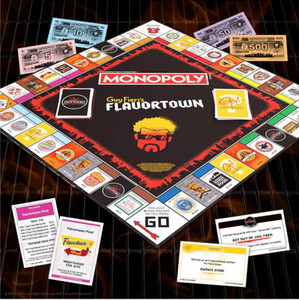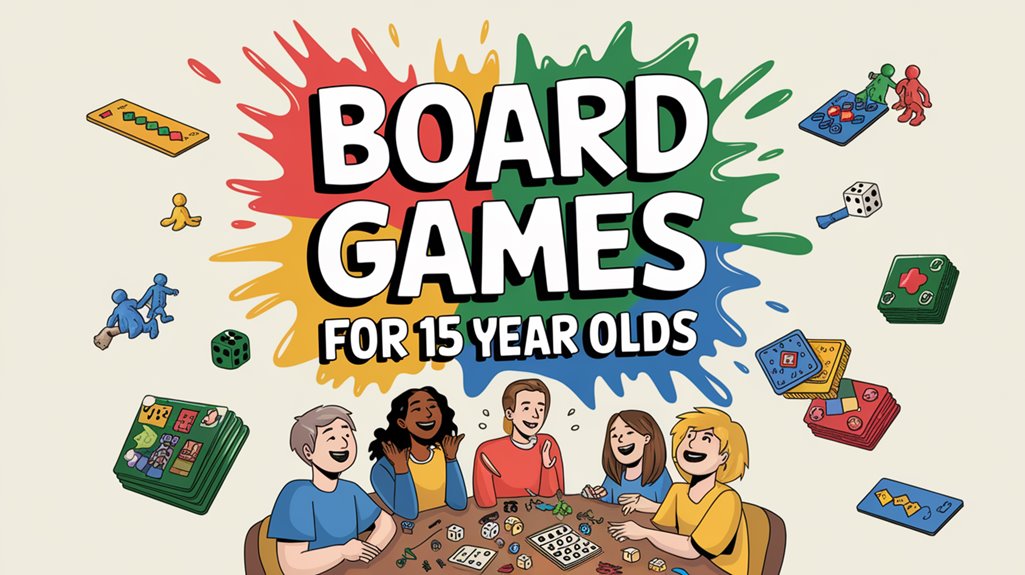Food-themed tabletop games have surged in popularity, blending strategic mechanics with appetizing visuals. Games like “Sushi Go” showcase elegant card-drafting while “Throw Throw Burrito” adds dexterity elements to traditional gameplay. Their success stems from universal appeal—everyone eats—plus tactile components that often resemble their edible inspirations. What drives this gastronomic gaming trend, and which titles truly deserve a place at the table?
Key Takeaways
- Popular food-themed games include “Sushi Go,” “Monopoly: Flavortown,” “Throw Throw Burrito,” and “Pancake Anarchy”
- Food-themed board games typically accommodate 2-8 players, making them versatile for various social gatherings.
- Game mechanics like drafting, set collection, and worker placement create engaging strategic experiences with culinary themes.
- Prices range from budget-friendly options at $13 to premium experiences at $44, offering choices for different budgets.
- These games foster social interaction through universal food themes while providing gameplay suitable for all ages.
Food-Themed Gaming Explosion
While traditional board games have long dominated tabletop entertainment, the culinary-focused gaming niche has experienced unprecedented growth in recent years. Market analysts attribute this food-themed gaming explosion to mechanics that resonate with diverse player demographics, melding strategic depth with approachable themes.
- Mechanisms like worker placement and set collection, executed through gastronomic frameworks, provide sublime decision spaces that support meaningful player choices
- Customizable player counts (2-5+) accommodate varied social contexts, from intimate duels to raucous gatherings
- Visual design utilizing vibrant culinary iconography creates immediate shelf appeal, enticing both casual browsers and dedicated collectors
- Cross-pollination between the Best Board Games community and foodie culture has spawned themed board variants discussed on platforms like BGG, encouraging meta-gaming engagement
This convergence of accessibility and strategic depth continues fueling the category’s expansion.
Foodie-Friendly Gaming Explosion
As culinary culture increasingly infiltrates mainstream entertainment, food-themed board games have emerged as a distinct subcategory generating unprecedented market traction. This phenomenon parallels the surge in food-centric Netflix series, with both mediums celebrating gastronomic experiences through engaging visual presentations.
The tabletop renaissance has birthed a smorgasbord of culinary-themed titles accommodating 2-8 players, democratizing access regardless of gaming expertise. Games like “Sushi Go” and “Monopoly: Flavortown” employ vibrant aesthetics and resource management mechanics that simulate authentic culinary experiences without constraint. The board game industry has recognized the universal appeal of food as a connective medium, crafting experiences that transcend mere gameplay to encourage genuine social interaction. These titles effectively utilize thematic immersion through strategic design elements, satisfying players’ hunger for both entertainment and culinary appreciation.
Sushi Card Collecting Challenge
Among the standout titles in the food-themed board game renaissance, “Sushi Go” exemplifies the elegant simplicity that characterizes successful culinary gaming experiences. This quick-play drafting mechanism generates tactical depth through hand management, with players simultaneously executing card drafting techniques while anticipating opponents’ moves.
| Sushi Type | Scoring Mechanism | Strategy Element |
|---|---|---|
| Nigiri | Direct point value | Risk/reward timing |
| Maki Rolls | Majority scoring | Competitive drafting |
| Sashimi | Set collection | Long-term planning |
| Tempura | Paired sets | Tactical flexibility |
| Wasabi | Multiplier effect | Combo potential |
Scoring combinations analysis reveals multiple viable paths to victory. Advanced sushi strategy tips include reading the “card river” flow, monitoring opponent collection patterns, and deliberately disrupting potential combos with defensive picks. The vibrant presentation and accessible design disguise surprisingly intricate decision trees that reward strategic depth without sacrificing approachability.
Monopoly: Flavortown
If traditional Monopoly represents the conservative real estate market, then “Monopoly: Flavortown” transforms the property acquisition experience into an extravagant culinary adventure worthy of its namesake celebrity chef. This $36 Amazon offering features Guy Fieri favorites as collectible tokens—including a cheeseburger and Camaro—that transport 2-6 players straight into the extravagant world of flavor.
Flavortown strategy tips emphasize trading iconic food destinations rather than Atlantic Avenue or Boardwalk. Players engage in a culinary trivia showdown while managing properties inspired by Fieri’s gastronomic journeys across America. The game brilliantly balances competitive property management with thematic immersion, creating a robust entertainment experience that satisfies both board game enthusiasts and Food Network devotees alike. It’s the perfect centerpiece for game nights where the freedom to investigate flavor meets tactical gameplay.
Burrito Throwing Battles
While Monopoly: Flavortown transforms tabletop gaming into a culinary real estate adventure, “Throw Throw Burrito” abandons traditional seated gameplay entirely for dynamic food-themed physical combat. This innovative hybrid merges card-matching mechanics with kinetic burrito toss strategies, creating a medium-weight game experience that scales beautifully for 2-6 participants.
The game’s chaotic scoring mechanics reward tactical card collection while simultaneously demanding physical dexterity to avoid incoming projectiles. Priced at approximately $40, this 15-30 minute experience delivers exceptional dollars-to-fun ratio for family game nights, striking the perfect balance between strategic depth and accessible gameplay.
What distinguishes “Throw Throw Burrito” within the tabletop ecosystem is its seamless integration of physicality with traditional gaming elements—creating a liberating play environment where laughter becomes as integral to success as skillful card management.
Sriracha Heat Challenge
Three design elements distinguish “Sriracha Heat Challenge” from conventional card games: its iconic hot-sauce-inspired packaging, whimsical culinary illustrations, and tightly compressed 10-15 minute gameplay sessions. This rapid-fire experience liberates players from the commitment traditional tabletop games demand, making it perfect for spontaneous gatherings.
The gameplay centers around lightning-fast reflexes as participants slap cards depicting various spicy challenges, requiring shrewd card strategy and split-second decisions. The mechanics brilliantly mirror the kick of actual Sriracha sauce—sudden, exciting, and attention-grabbing.
What raises this beyond mere novelty is its cross-generational appeal. Both children and adults find themselves similarly engaged in the competitive slapping mechanics, creating a democratized gaming environment where reaction time, not experience, determines success. The game’s visual language communicates its spirited intent immediately to newcomers.
Spam Yahtzee Dice Fun
Unlike its more impulsive counterpart in the hot sauce realm, Yahtzee: SPAM transforms a beloved dice classic through culinary reimagining that amplifies both gameplay and thematic coherence. The integration of iconic SPAM recipes like Musubi into scoring mechanics demonstrates remarkable culinary creativity while maintaining the strategic depth aficionados expect.
At $28, this accessible tabletop experience cultivates a delicate balance between dice strategy and fortune, appealing to players across experiential spectrums. The game’s ingenious thematic execution serves as a conversational trigger during social gatherings, liberating hosts from awkward silence.
What distinguishes this iteration is its demographic versatility—crossing generational boundaries with ease. The fusion of nostalgic SPAM iconography with tactical gameplay creates an intellectual playground where both culinary enthusiasts and strategy devotees find common ground, unfettered by age constraints.
Pancake Anarchy Stacking
Shifting from processed meat dice games to breakfast-inspired card play, Pancake Anarchy Stacking represents the chaotic counterpoint in food-themed tabletop entertainment. This affordably priced ($13) gateway experience invites 2-5 participants into a realm of pancake topping creativity, where the conventional breakfast hierarchy dissolves into delicious disorder.
The game’s architecture brilliantly enables chaotic gameplay strategies through its diverse card array—featuring various pancake bases and toppings that generate virtually limitless culinary combinations. Each round culminates in the ritualistic exclamation “Anarchy Pancakes!”—a battle cry that punctuates the deliberate disorder.
Perfect for family game night, this system nurtures social engagement and spontaneous laughter. The emphasis on unexpected combinations rewards imaginative stacking approaches, ensuring each session delivers fresh experiences in spite of its straightforward mechanics.






